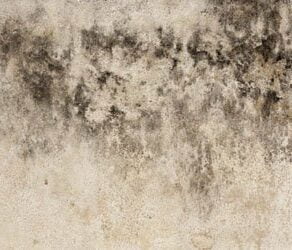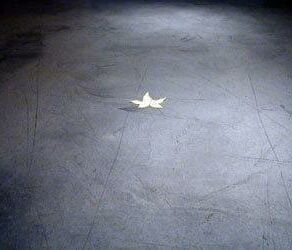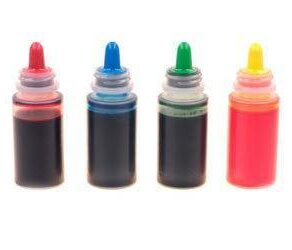Doug asked: How do I clean mold on cement block wall and cement floor? One end of my shop is built into the side of a hill. I am in Minnesota, so the inside wall below grade is usually cold, or cool, and damp. Mold forms on the lowest two feet of the back wall, as well as the cement floor in the back corners. The walls and floor are painted. What is the best way to remove the mold? I want to clean it up so it can be repainted.
Moisture  can move through underground cement in many ways. Often there are moisture barriers in place, but they can wear out and become less effective over time. The porosity of cement blocks make it a key area for mold growth. The moisture is able to get it, but has no way of drying up, which makes the perfect landing spot for mold spores to prosper. No matter how the moisture got there to begin with, it’s important to remove the mold completely. Be prepared to put some work into it. The materials are easy – but it’s going to take plenty of elbow grease to get rid of the mold completely.
can move through underground cement in many ways. Often there are moisture barriers in place, but they can wear out and become less effective over time. The porosity of cement blocks make it a key area for mold growth. The moisture is able to get it, but has no way of drying up, which makes the perfect landing spot for mold spores to prosper. No matter how the moisture got there to begin with, it’s important to remove the mold completely. Be prepared to put some work into it. The materials are easy – but it’s going to take plenty of elbow grease to get rid of the mold completely.
You Will Need:
- Long sleeves and pants
- Goggles
- Mask
- Water
- Bleach
- Bucket
- Scrub brush or sponge
- Rubber gloves
Steps to Remove the Mold:
- Mold is a toxic substance. Protect yourself by wearing long sleeves and pants, goggles, and a breathing mask. You can rent a respriator from a hardware store if needed. There are also hooded coveralls that can be found at hardware stores or online.
- Bleach is a well-known killer of mold and bacteria. In this case, it’s the perfect cleaning agent to kill and remove the mold completely.
- Start by mixing 1 part bleach with 4 parts water in the bucket.
- Put on rubber gloves to protect your hands and wear old clothing as they will likely get a splash or two of bleach on them. If you can wear clothes you wouldn’t mind throwing in the trash when you’re done, that would be ideal.
- Use a scrub brush or sponge, depending the surface and severity of the mold, and dip it in the bleach solution.
- Scrub the mold with the solution until it is gone.
- When all of the mold is removed, dry the area completely by patting the surface with towels to remove excess moisture, then pointing a fan on the area if needed.
- Consider sealing the concrete with a mold repellent to prevent its return. These products can be found at hardware stores. Moldex is one popular example.
Additional Tips and Ideas
- Protect yourself when using bleach. Always wear protective rubber gloves and open any doors or windows to allow for proper ventilation.
- If you are planning to paint the area, consider applying a sealant to the area to prevent moisture from coming through again.
- There are commercial mold removers available at most hardware and home improvement stores. They are specifically designed to remove mold from concrete walls and floors.
Sources
- How to Clean Practically Anything by Consumer Reports
- Cleaning Plain & Simple by Donna Smallin









Very good article on cleaning up mold from cement. However, I would add that the person cleaning should also wear a respirator (just something simple from the hardware store) – you don’t want to be breathing the mold spores.
Additionally, if your mold is in the basement and you can see it, I would not run HVAC until it is cleaned up. It may spread the spores throughout the house.
I use full strength bleach in a spray bottle. Just soak the cement wall with the bleach, let it stay for an hour, then wash it clean.
This is not a mold question. We have the mold removed and painted the cement floor. Unfortunately, white paint got on the sand color paint; we removed it and we now have black steel marks on the cement and paint. We need to be able to remove those. We have used Spic and Span, also a Mr. Clean Eraser. Neither have hardly touched the black left behind. We need to get this repainted with the sealant paint, but need the black gone first. Any suggestions?
I would appreciate any suggestions that anyone has on how to remove steel black scratch marks on a concrete garage floor, since we have moved some appliances.
If you have any procedure that will remove these marks, please send me whatever works the best. I am trying to get the garage cleaned up, and am having trouble removing the steel black scratch marks left by moving heavy side-by-side refrigerator, and large freezer.
Thanking you in advance,
Linda
Wet the floor, then sprinkle dust from the actual cement bag all around the concrete slab you are trying to clean. Then, grab a push broom and spread it out; might get a bit dusty, but you will be amazed at the results
Just like new.
Works on oil spills too
I have one addition to Maureen’s suggestion to use a respirator. I strongly urge anyone contemplating working around mold to wear safety goggles. I cleaned a dehumidifier outdoors, and now have fungal keratitis in my left eye. Keratitis is painful and threatening my vision in that eye. Bleach droplets from a scrub brush could be harmful, too. If you develop a red, itchy eye after working on black mold, just immediately get yourself to an ophthalmologist (not optometrist). Or save yourself a lot of pain and trouble and wear wrap-around goggles.
Thanks for your suggestion, Christine. I plan to do some scrubbing and will seek out some eye protection.
Can mold grow inside concrete slabs via cracks where there is water intrusion and there are steel and steel cables within the concrete?
Can mold grow inside concrete walls after years of water intrusion?
Ed, if moisture and air are present, mold can grow. Also, moisture and air can travel through the concrete, carrying with them mold spores. However, it is unlikely that mold would grow on the inside of a slab of concrete because the air flow is so low. In cracks, however, air flow would be greater.
Source: University of Illinois
Source: Iowa State University
You can’t clean mold off of cement. Cement is actually a microparticle that is the binder in concrete and concrete block.
Calling concrete “cement” is the same as calling bread “flour.” It is only one ingredient in the mix.
Hi, we have a white furry mold on a ground floor concrete block wall. We have washed the areas with bleach a number of times, but the mold returns. The block feels damp on the inside, but I have drilled holes from the outside thinking maybe there’s water, but each cavity is dry. I do wonder if our daughter’s cat may have sprayed and the mold is the effect. We are now going to try a number of different cleaners on the different spots. Any other ideas appreciated. Just a note that the outside wall is a sun trap.
Ok, the wall has been cleaned of mold; then what do you do?? Paint, or more mortar???
1. Wash and scrub the floors and walls with mild detergent and hot water. Remove all dirt completely. Wash away all mold. The mold needs dirt to survive.
2. Sprinkle borax and scrub further in areas that are suspect, particularly the corners.
3. Spray with vinegar. You may need 3 liters or more.
Do this every spring and run a dehumidifier.
If you paint the cement, the moisture will just mold behind the paint.
We have mold on the inside of a basement wall. We have the walls finished, but not the ceiling; that is how we saw mold. I have cleaned with TSP before, but it keeps coming back. It is in a corner near the walk-out side of our basement. At first, we thought it was because of a drain near that corner, but we have rerouted drain and still mold is coming back. I have taken out a portion of the dry wall. Some mold has started behind insulation, but most is above the finished area. I clean every year, but we plan to finish the ceilings and I need to do something to keep it from coming back.
I hesitated to use this site when I saw the “cement” walls. Walls are not made of cement. They are made of concrete, which is made from cement, among other ingredients. No one would shop for a loaf of flour.
Just opened my cement in ground pool and have black mold on the cement cowling around top edge of pool. It is adjacent to the opening for the baskets that drain the pool. What is the best way to clean this area?
I have an office that is on grade, concrete over the dirt. I cleaned it a few times with bleach and have carpet tiles covering the floor again. How often do you have to re-bleach it? It’s hard to tell since the bleach did not remove the stains.
If I keep the floor covered with the carpet tiles, is it safe, if the mold is not given a place to go? Thank you for any help.
Marcia,
You only have to rebleach the area if the mold returns. The hope is that the bleach killed all of the mold. However, if you had carpet tiles covering the area while it was moldy and replaced the same carpet tiles, it’s very likely that there were mold spores on the tiles themselves, and therefore that the mold will return. If the mold returns, clean the cement again and use the article How to Remove Mold from Car Carpeting to clean the top and bottom of the carpet tiles.
Also, the carpet tiles are not air-tight, so they will not prevent the mold from returning or make it any safer for you to be in a room that contains mold.
Melanie, thanks for the feedback. It was new carpet, but now there is mold under there. I will toss and re-do the floors, but maybe this time just seal the concrete if I can; there are some cracks and warping up… and leave it uncovered… yuk.
My big question refers to ‘Steps to Remove’ section: How ever does one “dry the area thoroughly” in a cement block garage/workshop? I can see that a dehumidifier might help once dry, clean… but wonder about drying anything thoroughly. Thanks!
Sandy,
Start by patting the cement dry (or removing as much excess water as possible) with a towel, then ventilate the area well to help the cement air dry or point a fan on the area. After that, a dehumidifier should work well to help fully dry out any remaining moisture.
I live in a concrete cement studio. It is made out of those blocks and painted. Every now and then, I smell what smells like a wet rag that’s been sitting around for years. I have a keen sense of smell. The owner isn’t doing anything because she couldn’t smell it. It’s NOT a constant odor and there is no fuzzy growing anywhere at least visible. Does this sound like an issue? She only takes cash for rent and told me to spray Febreze. What could I do? I know what I smell and don’t want to pay as it’s not my place?? I guess if I want to make sure I don’t end up with cancer, I should probably pay someone. Thanks.
I have people living in a walk-in apartment. In front of the door is a room that holds the meters and sewer that is cleaned every six months by a pro sewer cleaner. This room is underneath steps. We had a leak about 15 years ago and changed the steps. A tenant noticed black spots on the concrete and on the painted door. She scrubbed the painted door. What should be done with the spots on the concrete, and should they be painted after washing?
Jean,
The steps in the article should work to remove the mold from the concrete. However, it is possible that the mold could grow back. Painting the surface is something you can do for aesthetics, but it is not a solution to the mold. If you decide to paint the surface, seal the surface first to keep moisture out so that mold can’t grow back and eat through the paint. Sealing the concrete can help to prevent moisture and air from entering the concrete through the surface (and feeding the mold, since mold needs moisture and air to grow).
Source: Mould Facts – Mould Facts and Myths